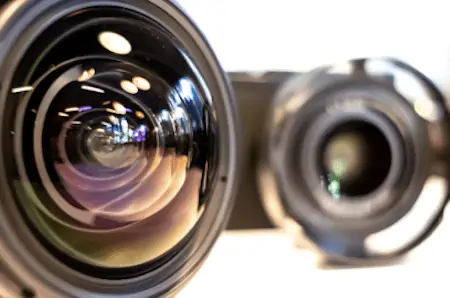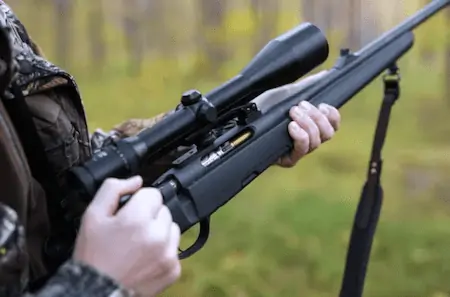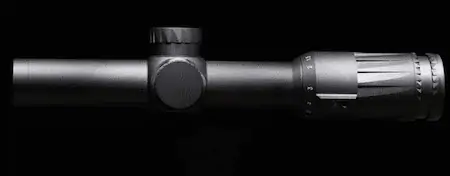When buying a new variable rifle scope, there are many factors you might consider.
However, an overlooked factor that many enthusiasts miss is whether the reticle of your scope is placed on the first or second focal plane. To some, this might be confusing and thus difficult to consider when buying a new rifle scope.
This article will try to help you understand the first focal plane vs. second focal plane debate.
Let’s get started!
Table of Contents
What Is The Focal Plane?
Before we can actually get to what we mean by first or second focal planes, we need to understand what a focal plane is. A focal plane is an area in an image within which an object or objects are in sharp focus.
When you’re using your scope to target something, you will want the target to appear as clear as possible so that you can make a proper and accurate shot. When you look at objects or animals from very far away, they appear out of focus.
A rifle scope will allow you to adjust the magnification to better focus on your target. So you can guess how important the focal plane is to acquire your target.
The light that enters the lens converges at a point in the plane called the focal point. And the length between the lens and focal point is known as the focal length. A scope or lens can magnify an image by altering the focal length.
This allows one lens or scope to be used in many different situations. So, the magnification capabilities of your scope and how well the reticle works with it depend on these.
With that cleared, we can now move on to the next part.
What Does The First And Second Focal Plane Refer To?
You’ll often hear these two terms being thrown around when you go to buy your rifle scope.
These simply refer to the placement of the scope reticle. The first focal plane refers to the scope reticle being placed in front of the magnification lenses.
In the case of a second focal plane, the scope reticle is placed behind the magnification lenses.
As a result, in some places, the second focal plane is also referred to as a rear focal plane. Just this simple difference in placement causes the two types of scopes to act very differently.
First Focal Plane
To understand a bit more about first focal planes, think of it this way: in a variable magnification scope, the target who sits in front of the magnification lens will grow in size when magnification is increased.
Since the reticle is a set of markings etched onto the eyepiece of a scope, said reticle would also expand alongside the target when magnification is increased.
Similarly, it will also shrink if magnification is decreased. Do note that you’ll only see this difference if your scope has variable magnification.
-
Manufacturing
First focal plane scopes are manufactured commonly in Europe and are more expensive than their counterpart. This is because to ensure that the reticle scales with magnification, it has to be etched into the glass very small.
Coupled with the fact that some advanced reticles are used in this setting, it is somewhat expensive to accurately etch into glass. At such sizes, a small difference in measurement can cause a large error, thus throwing off the aim.
So, in the process of making one lens, there will probably be many defective lenses.
-
Zooming
When you zoom in on a target, the size of the reticle will increase. This might lead to an issue where your target becomes partially obscured by the reticle. And this is a difficult problem to overcome if you’re hunting something small like a bird.
This also ties in with another issue that can plague first focal plane users. In low light environments, the more you zoom in on a target, the less light that will enter the lens.
This alone makes things difficult, but remember that your reticle also increases in size as you increase magnification.
In these conditions, your reticle will often make it harder to aim and so acquiring your target is quite tedious, and at times, impossible.
-
Variations
A lot of these basic principles apply to simple reticles such as Duplex. Some complexities arise when dealing with reticles such as Bullet Drop Compensating reticles and Wind Drift or Christmas Tree reticles.
If you’ve seen these reticles, you’ll notice that they have some stadia marks or some lines going downwards. These represent a fixed distance and are used to account for bullet trajectory and winds.
As you already know, the first focal plane reticles change in size proportionately with the target. This thankfully doesn’t throw off the pre-made calculations that went into designing the special reticles.
-
Additional Features
Since your reticle changes in size with your target, the measurements represented by the stadia lines remain constant, and thus, the calculations remain valid at any distance. So, ballistic reticles are meant to work in perfect tandem with the first focal planes.
This allows someone using a rifle to make minute adjustments very quickly. For example: if you’re on a hunt, you may spot your prey very close to you or even far. If you wanted to compensate for say, wind, you wouldn’t have to worry about calculations.
Also, you can easily adjust the magnification for different distances, and you’ll be greeted with accurate results.
If you have a scope that you don’t know what configuration it is in, then you can simply check by changing the magnification settings, and then seeing through the scope.
And if the reticle changes with the target, then the scope is in the first focal plane setting. That is more or less the underlying principles and uses of first focal plane settings.
Now we move on to second focal plane settings.
Second Focal Plane
Second focal plane configurations refer to your reticle being placed behind the magnification lens.
What this entails is that when magnification settings are increased, you will notice your target getting bigger, but the size of the reticle remains the same.
Since the reticle is placed behind the magnification lens, the reticle is not being magnified – only the target becomes magnified.
As you can see, this is in direct contrast to the first focal plane setting. Low power variable scopes often make use of second focal plane settings.
-
Target
Since the size of the reticle doesn’t decrease, it prevents the reticle from obscuring the target if it’s very small. This allows the user to pick up targets much faster and easier.
However, do note that at higher magnifications, the reticle might appear much smaller than the target, and it might be easy to lose it in a busy background.
You will also face a reduction in precision due to the small size of the reticle at larger magnifications.
This type of scope configuration is still appreciated by hunters. The size of the reticle remains the same, so for beginners, it’s a lot less stress-inducing to change the magnification and then deal with an enlarged sight or reticle.
And since they work in lower magnifications, more light enters the lens, and as a result, the second focal plane configuration is very helpful for low-light environments.
Second focal plane configurations combine fast target acquisition and ability to work in low light environments in order to make them fast and easy to use.
-
Settings
Second focal plane settings do face a significant issue. First focal plane settings work very well with ballistic reticles such as bullet drop compensating reticle or wind drift reticle and help a shooter adjust for common obstacles.
Second focal planes work very badly or often do not work at all with such advanced reticles.
On low power settings, the stadia marks on the reticle appear quite small alongside the target. This makes it very difficult to align the stadia marks and make accurate shots.
While in some cases, the second focal plane bullet drop compensating reticles are often calibrated to work in the highest power (you’ll likely be using the highest magnification to hit a target at long-range) and thus make them usable.
The problem comes when you need to readjust your aim.
In any magnification setting lower than that, the calibrations of the reticles no longer hold, and the measurements become inaccurate.
The problem with the reticle becoming obtrusive also becomes more of an issue when you need to adjust your scope.
While this can somewhat be overcome through practicing your aim and taking the time to do some manual rough calculations, you might end up losing your target because you took too much time aiming and fiddling with your scope.
Since the scope reticle is closer to your eye, it does make it easier to make an estimate when shooting at a power lower than the maximum power of your scope.
FFP Vs. SFP
By now, you’ve got an idea of how the two different configurations work. Though you might still ask which one is better and how they fare in different situations. There’s no straightforward answer to that.
Advanced reticles such as ballistic reticles work very well with first focal planes, but with a lot of practice, one can overcome that issue when using second focal plane settings, although the process is long and arduous.
It should be noted that there are some activities and functions better suited for each setting.
To give you a general idea:
First Focal Plane Setting Is Best Used For
-
Precision Shooting
This setting allows for high accuracy since the target and reticle both increase in size. It is much easier to aim for vital spots using a larger reticle if the target is far away.
-
Correctly Estimating The Range
With reticles such as MilDot and BDC working so well with a first focal plane, one can accurately determine the range to a significant degree of accuracy.
If you practice a bit, it is very much possible to reliably hit far off-targets.
-
Compensating Windage And Bullet Drop
Again, ballistic reticles work well with first focal plane settings and thus allowing one to reliably work against the wind.
-
Quickly Adjusting Magnification
First focal plane settings work their magic at a long-range, but even so, one can adjust the magnification to their liking.
They work well enough at all powers and so one doesn’t have to keep the scope set at the maximum possible power. This also allows more flexibility in usage.
Second Focal Plane Setting Is Best Used For
-
Close Range Shooting
Scopes set in this setting work their best when used in close range. They are made to acquire targets as fast as possible, and at close enough range, magnification isn’t too much of an issue.
-
When a Constant Sized Reticle Is Required
At close ranges and low magnification settings, the reticle of a first focal plane configuration appears quite small since it scales with the target.
However, for a second focal plane setting, the reticle size is constant and at close ranges is usually much bigger than the first focal plane settings.
So, if you have trouble spotting the reticle or would like for the reticle to be of a constant size so that it does not throw off your aim, a second focal plane configured reticle will do wonders.
-
If Don’t Need To Constantly Adjust The Magnification
A second focal plane reticle works well at medium to long-range if the power is set to maximum, and you don’t need to change it.
So, it is good to use if you hunt for birds.
-
For Competitions
Competitions will make use of second focal plane reticles to ensure a fair and balanced contest. If you want to improve your skills, then using a second focal plane reticle will definitely help.
Conclusion
Even so, in the end, it is a matter of your own preference as to which setting you use.
Hopefully, you now have a good enough idea of how the two different settings work and how you can maximize their usage.
When going to buy a new scope, you should now consider how these two settings can change your performance.
Happy hunting!



